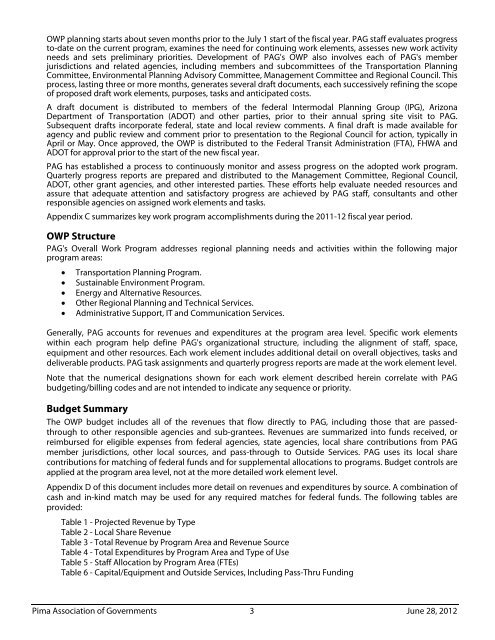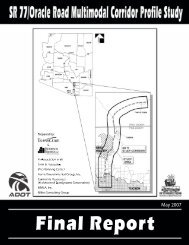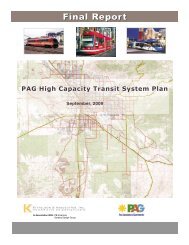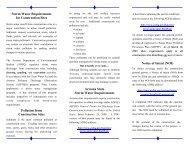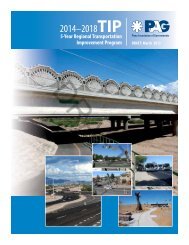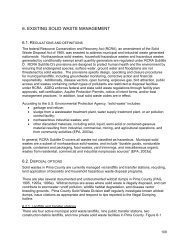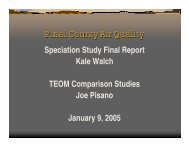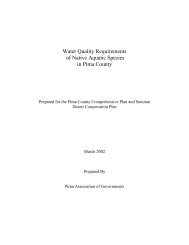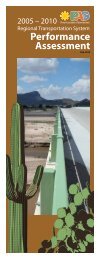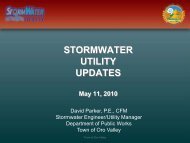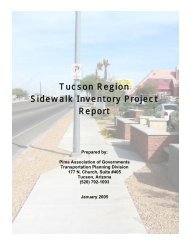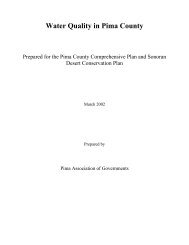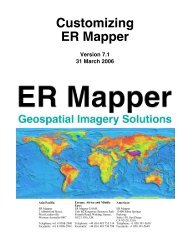Overall Work Program - Pima Association of Governments
Overall Work Program - Pima Association of Governments
Overall Work Program - Pima Association of Governments
Create successful ePaper yourself
Turn your PDF publications into a flip-book with our unique Google optimized e-Paper software.
OWP planning starts about seven months prior to the July 1 start <strong>of</strong> the fiscal year. PAG staff evaluates progress<br />
to-date on the current program, examines the need for continuing work elements, assesses new work activity<br />
needs and sets preliminary priorities. Development <strong>of</strong> PAG's OWP also involves each <strong>of</strong> PAG's member<br />
jurisdictions and related agencies, including members and subcommittees <strong>of</strong> the Transportation Planning<br />
Committee, Environmental Planning Advisory Committee, Management Committee and Regional Council. This<br />
process, lasting three or more months, generates several draft documents, each successively refining the scope<br />
<strong>of</strong> proposed draft work elements, purposes, tasks and anticipated costs.<br />
A draft document is distributed to members <strong>of</strong> the federal Intermodal Planning Group (IPG), Arizona<br />
Department <strong>of</strong> Transportation (ADOT) and other parties, prior to their annual spring site visit to PAG.<br />
Subsequent drafts incorporate federal, state and local review comments. A final draft is made available for<br />
agency and public review and comment prior to presentation to the Regional Council for action, typically in<br />
April or May. Once approved, the OWP is distributed to the Federal Transit Administration (FTA), FHWA and<br />
ADOT for approval prior to the start <strong>of</strong> the new fiscal year.<br />
PAG has established a process to continuously monitor and assess progress on the adopted work program.<br />
Quarterly progress reports are prepared and distributed to the Management Committee, Regional Council,<br />
ADOT, other grant agencies, and other interested parties. These efforts help evaluate needed resources and<br />
assure that adequate attention and satisfactory progress are achieved by PAG staff, consultants and other<br />
responsible agencies on assigned work elements and tasks.<br />
Appendix C summarizes key work program accomplishments during the 2011-12 fiscal year period.<br />
OWP Structure<br />
PAG's <strong>Overall</strong> <strong>Work</strong> <strong>Program</strong> addresses regional planning needs and activities within the following major<br />
program areas:<br />
• Transportation Planning <strong>Program</strong>.<br />
• Sustainable Environment <strong>Program</strong>.<br />
• Energy and Alternative Resources.<br />
• Other Regional Planning and Technical Services.<br />
• Administrative Support, IT and Communication Services.<br />
Generally, PAG accounts for revenues and expenditures at the program area level. Specific work elements<br />
within each program help define PAG's organizational structure, including the alignment <strong>of</strong> staff, space,<br />
equipment and other resources. Each work element includes additional detail on overall objectives, tasks and<br />
deliverable products. PAG task assignments and quarterly progress reports are made at the work element level.<br />
Note that the numerical designations shown for each work element described herein correlate with PAG<br />
budgeting/billing codes and are not intended to indicate any sequence or priority.<br />
Budget Summary<br />
The OWP budget includes all <strong>of</strong> the revenues that flow directly to PAG, including those that are passedthrough<br />
to other responsible agencies and sub-grantees. Revenues are summarized into funds received, or<br />
reimbursed for eligible expenses from federal agencies, state agencies, local share contributions from PAG<br />
member jurisdictions, other local sources, and pass-through to Outside Services. PAG uses its local share<br />
contributions for matching <strong>of</strong> federal funds and for supplemental allocations to programs. Budget controls are<br />
applied at the program area level, not at the more detailed work element level.<br />
Appendix D <strong>of</strong> this document includes more detail on revenues and expenditures by source. A combination <strong>of</strong><br />
cash and in-kind match may be used for any required matches for federal funds. The following tables are<br />
provided:<br />
Table 1 - Projected Revenue by Type<br />
Table 2 - Local Share Revenue<br />
Table 3 - Total Revenue by <strong>Program</strong> Area and Revenue Source<br />
Table 4 - Total Expenditures by <strong>Program</strong> Area and Type <strong>of</strong> Use<br />
Table 5 - Staff Allocation by <strong>Program</strong> Area (FTEs)<br />
Table 6 - Capital/Equipment and Outside Services, Including Pass-Thru Funding<br />
<strong>Pima</strong> <strong>Association</strong> <strong>of</strong> <strong>Governments</strong> 3 June 28, 2012


